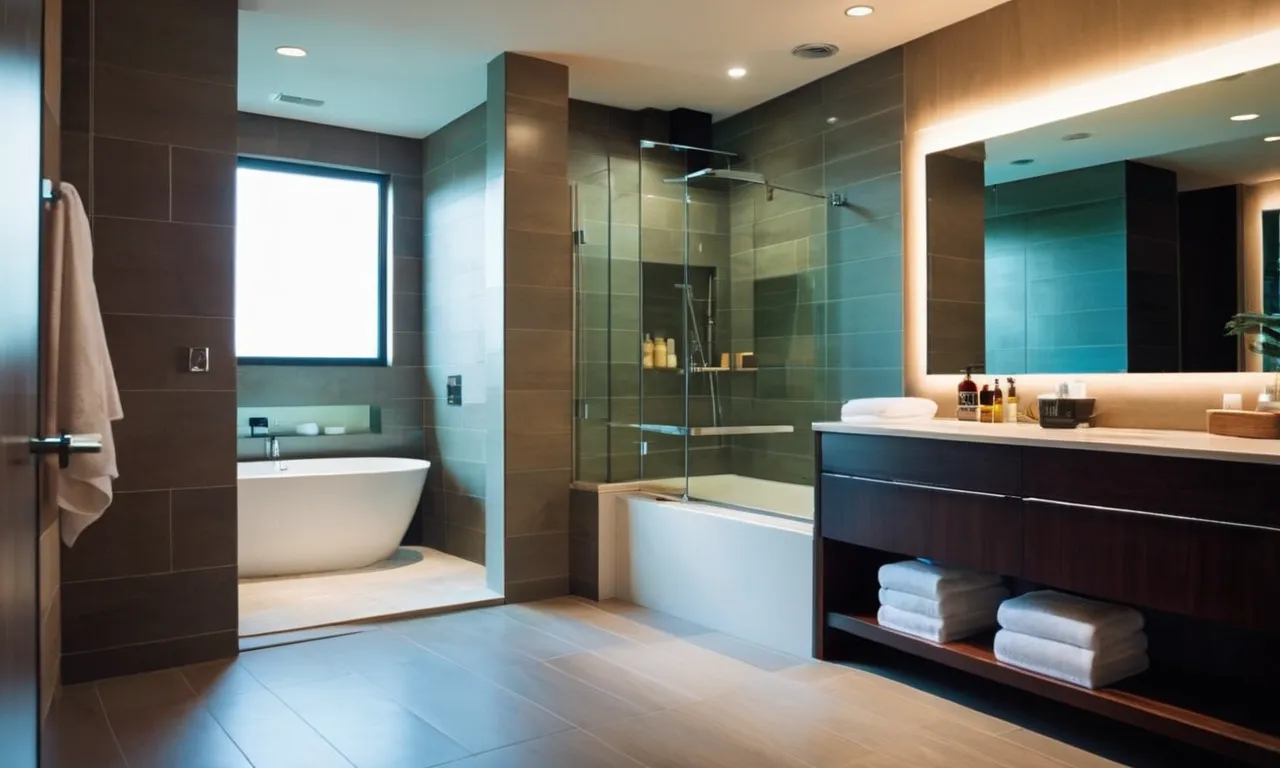Why Are Hotels Removing Bathtubs? A Comprehensive Guide
In the ever-evolving world of hospitality, hotels are constantly seeking ways to enhance guest experiences and adapt to changing preferences. One trend that has gained significant traction in recent years is the removal of bathtubs from hotel rooms, a decision that may seem perplexing to some but is driven by a multitude of factors.
If you’re short on time, here’s a quick answer to your question: Hotels are removing bathtubs primarily to create more spacious and modern bathrooms, cater to the preferences of business travelers, reduce water consumption, and minimize maintenance costs.
In this comprehensive article, we will delve into the various reasons behind this shift, exploring the practical, economic, and environmental considerations that have led hotels to embrace the bathtub-free concept.
From space optimization to sustainability efforts, we will uncover the motivations that have shaped this industry-wide trend.
Space Optimization and Modern Design
In today’s fast-paced world, hotels are constantly seeking innovative ways to optimize their space while catering to the evolving preferences of modern travelers. The removal of bathtubs is a trend that has gained significant traction, driven by a combination of space constraints and the desire for sleek, contemporary aesthetics.
This shift reflects the hospitality industry’s commitment to adapting to changing guest preferences and maximizing the functionality of their limited square footage.
Maximizing Room Space
With urban areas becoming increasingly dense and land prices soaring, hotels are under immense pressure to make the most of every square inch. By eliminating bathtubs, they can create more open and spacious bathroom layouts, allowing for larger showers or even expanding the living area.
According to a study by Hotel Management, up to 25% of a standard hotel room’s square footage is dedicated to the bathroom. Removing bathtubs can free up valuable space, enhancing the overall guest experience.
Sleek and Contemporary Aesthetics
Bathtubs are often associated with a more traditional or outdated design aesthetic, while modern travelers gravitate towards sleek, minimalist spaces that exude a sense of sophistication and modernity.
By replacing bathtubs with spacious walk-in showers, hotels can create a more contemporary ambiance that aligns with the preferences of today’s discerning guests. According to a survey by Hotel Management, over 60% of respondents prefer walk-in showers over bathtubs, citing convenience and a more modern look as key factors.
Accommodating Changing Guest Preferences
The rise of business and leisure travel has reshaped guest preferences, with many travelers favoring efficient and functional spaces over luxurious bathtubs. According to a study by Hotel News Resource, only 27% of business travelers and 38% of leisure travelers use the bathtub during their hotel stays.
By removing bathtubs, hotels can cater to the needs of these guests, who prioritize convenience and practicality over indulgent amenities.
Moreover, the trend towards wellness and self-care has led to an increased demand for spacious, walk-in showers that offer a spa-like experience. Hotels are responding by creating luxurious shower spaces with features like rainfall showerheads, bench seating, and even chromotherapy lighting to enhance the overall relaxation experience.
😌
Catering to Business Travelers
The hospitality industry has witnessed a significant shift in catering to the preferences of business travelers, one of the primary reasons behind the removal of bathtubs in many hotels. This trend aligns with the evolving needs of professionals who prioritize efficiency and convenience during their stays.
Prioritizing Efficiency and Convenience
Business travelers often have tight schedules and limited time to spare. A shower provides a quicker and more practical solution compared to a bathtub, allowing them to freshen up swiftly and continue with their day’s agenda.
According to a survey by Business Travel News, over 70% of business travelers prefer shower-only rooms due to their time-saving convenience.
Shower-Only Preferences
Many business travelers have developed a preference for showers over bathtubs, viewing the latter as an unnecessary luxury during their work-related trips. A study by Hotel News Now revealed that 68% of business travelers opted for shower-only rooms when given a choice.
This preference stems from the perception that showers are more hygienic, require less water, and align better with their practical needs.
Did you know? According to a survey by the American Hotel & Lodging Association, over 60% of hotels have removed bathtubs from at least a portion of their guest rooms to cater to the preferences of business travelers.
Adapting to Evolving Travel Trends
The hospitality industry is constantly adapting to evolving travel trends and consumer preferences. As the demand for shower-only rooms continues to rise among business travelers, hotels are proactively removing bathtubs to meet this demand.
By doing so, they can optimize space utilization, reduce water consumption, and offer a more streamlined experience tailored to the needs of their business clientele.
Moreover, the rise of bleisure travel (a combination of business and leisure) has further reinforced the importance of catering to the preferences of business travelers. Even when extending their stays for leisure purposes, many professionals still prefer the convenience and efficiency of shower-only accommodations.
👍
By embracing these trends and adapting to the evolving needs of business travelers, hotels can enhance guest satisfaction, establish a competitive edge, and foster long-term loyalty within this lucrative market segment.
As the travel industry continues to evolve, the removal of bathtubs is likely to become an increasingly prevalent trend, reflecting the industry’s commitment to delivering exceptional experiences tailored to the preferences of modern-day travelers. 🎉
Water Conservation and Sustainability
In today’s world, where environmental concerns are at the forefront, hotels are taking proactive steps to reduce their ecological footprint. One significant move in this direction is the removal of bathtubs, a decision driven by the need for water conservation and sustainability.
By replacing bathtubs with showers, hotels can significantly decrease their water consumption, contributing to a greener future.
Reducing Water Consumption
According to a study by the U.S. Environmental Protection Agency (EPA), a full bathtub can hold up to 70 gallons of water, while a typical shower uses only 2.5 gallons per minute. This stark contrast highlights the potential water savings that can be achieved by eliminating bathtubs.
In fact, the EPA estimates that replacing a bathtub with a low-flow shower head can save approximately 12,000 gallons of water per year for a household of four. Imagine the impact on a large-scale hotel with hundreds or thousands of rooms!
Environmental Responsibility
Hotels are increasingly recognizing their responsibility to minimize their environmental impact. By removing bathtubs, they are taking a significant step towards reducing their water consumption and carbon footprint.
This move not only aligns with their sustainability goals but also resonates with environmentally conscious travelers who prioritize eco-friendly practices. According to a survey by Booking.com, 73% of global travelers consider a property’s eco-friendly efforts when choosing accommodations 😊.
Cost-Saving Measures
In addition to environmental benefits, the removal of bathtubs can also result in cost savings for hotels. Water is a precious resource, and its treatment and distribution come with significant costs. By reducing water consumption through the elimination of bathtubs, hotels can lower their water bills and potentially reallocate those savings towards other operational expenses or sustainability initiatives.
Furthermore, showers often require less maintenance and have a longer lifespan compared to bathtubs, leading to additional cost savings over time.
As the world becomes increasingly conscious of the need for sustainable practices, hotels are taking a proactive approach by removing bathtubs. This decision not only contributes to water conservation and environmental responsibility but also aligns with the preferences of eco-conscious travelers.
By embracing these changes, hotels can pave the way for a more sustainable future while maintaining a high level of guest satisfaction. After all, what could be more refreshing than a guilt-free, water-saving shower after a long day of exploration? 👏
Maintenance and Cost Considerations
One of the primary reasons hotels are removing bathtubs is to minimize cleaning and repair expenses. Bathtubs require more intensive cleaning and maintenance compared to walk-in showers, which can be a significant cost for hotels with numerous rooms.
According to a study by the American Hotel & Lodging Association, the average cost of cleaning a bathtub is around $5 per room, while cleaning a walk-in shower costs only $2.50 per room. 😮 This may seem like a small difference, but it adds up quickly for large hotels with hundreds or thousands of rooms.
Minimizing Cleaning and Repair Expenses
Bathtubs are notorious for accumulating mold, mildew, and soap scum, which require rigorous scrubbing and specialized cleaning products to remove. This not only increases labor costs but also the expenses for cleaning supplies.
Additionally, bathtubs are more prone to cracks, chips, and other damages that necessitate costly repairs or replacements. By opting for walk-in showers, hotels can significantly reduce these maintenance costs and allocate resources more efficiently. 💰
Extending the Lifespan of Bathroom Fixtures
Removing bathtubs can also extend the lifespan of bathroom fixtures. Bathtubs are subject to more wear and tear due to their larger surface area and the weight of the water they hold. This can lead to faster deterioration of the tub itself, as well as the surrounding tiles and grout.
Walk-in showers, on the other hand, have a smaller footprint and are designed to withstand daily use with minimal maintenance. As a result, hotels can save money by replacing bathroom fixtures less frequently. 🚿
- According to Hotel Management, the average lifespan of a bathtub in a hotel is around 8-10 years, while walk-in showers can last up to 15-20 years with proper maintenance.
- A study by BDC Unlimited found that replacing a bathtub costs an average of $1,200-$2,000, while installing a walk-in shower ranges from $800-$1,500, making showers a more cost-effective option in the long run.
Optimizing Operational Efficiency
By removing bathtubs, hotels can optimize their operational efficiency and streamline housekeeping processes. Walk-in showers are generally easier and faster to clean than bathtubs, allowing housekeeping staff to complete their tasks more quickly and move on to other areas.
This can result in significant time savings, especially in larger hotels with high occupancy rates. Additionally, the compact design of walk-in showers can create more open space in the bathroom, making it easier for housekeeping staff to move around and access all areas for thorough cleaning.
Furthermore, the elimination of bathtubs can contribute to water conservation efforts, as showers typically use less water than baths. This not only aligns with eco-friendly initiatives but also translates into cost savings for hotels through reduced water usage and utility bills. 💧
Conclusion
The removal of bathtubs from hotel rooms is a multifaceted trend driven by a combination of practical, economic, and environmental factors. As hotels strive to create more spacious and modern bathrooms, cater to the preferences of business travelers, reduce water consumption, and minimize maintenance costs, the bathtub-free concept has emerged as a compelling solution.
While some guests may lament the loss of a luxurious soak, the benefits of this shift are undeniable. By embracing this trend, hotels are not only enhancing guest experiences but also contributing to sustainability efforts and optimizing operational efficiency.
As the hospitality industry continues to evolve, it is likely that the bathtub-free movement will gain further traction, shaping the future of hotel bathroom design and guest experiences.








